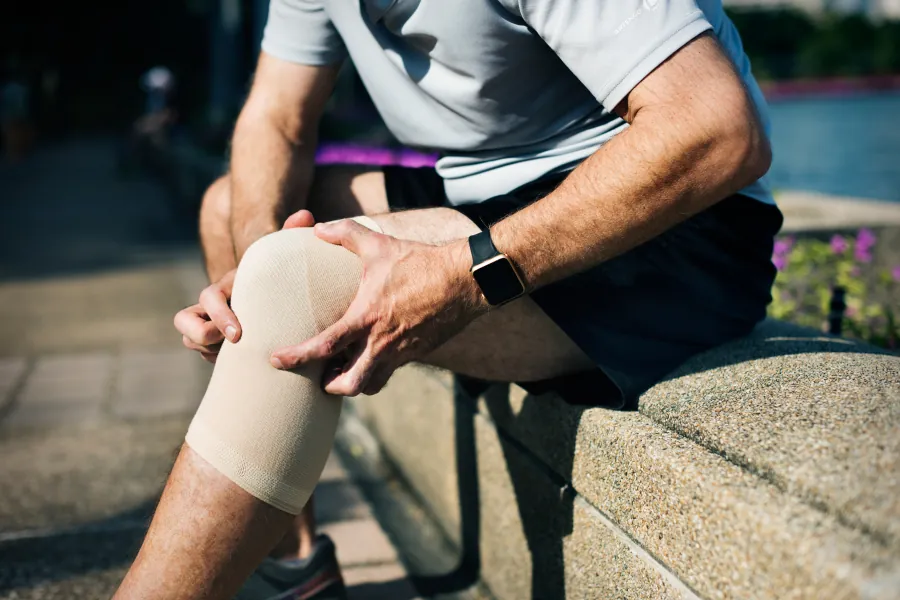Before we delve into the specifics, let’s understand what prepatellar bursitis actually is. Essentially, it’s inflammation of the bursa located in front of your kneecap. This small fluid-filled sac acts as a cushion between the patella and the skin and tendons overlying the knee joint.
What Causes Prepatellar Bursitis?
- Overuse: Frequent kneeling, especially on hard surfaces, is a common culprit. Activities like gardening, construction work, or even cleaning floors can put repetitive stress on the prepatellar bursa, leading to irritation and inflammation.
- Acute Injury: A direct blow to the kneecap, like a fall or a collision during sports, can damage the bursa and cause inflammation.
- Improper Form: Bad form during exercises like squats, lunges, or kneeling jumps can put extra strain on the kneecap and bursa.
- Increased Weight: Carrying excess weight puts more pressure on all your joints, including your knees. This can strain the bursa and make it more susceptible to inflammation.
- Underlying Conditions: In some cases, prepatellar bursitis can be associated with medical conditions like gout, rheumatoid arthritis, or certain infections.
How do you know if you have prepatellar bursitis?
Look out for telltale signs like swelling over the kneecap, tenderness, warmth, and pain, especially when kneeling or pressing on the affected area. If you notice these symptoms, it’s essential to seek medical advice for proper diagnosis and treatment.
Diagnosing Prepatellar Bursitis
Diagnosing bursitis typically involves a combination of physical examination and imaging tests such as X-rays or MRI scans. Your healthcare provider will examine the affected knee, looking for signs of inflammation and tenderness. Imaging tests help confirm the diagnosis and rule out other potential causes of knee pain.
Treatment Options of prepatellar bursitis
- Rest
- Ice Therapy for 15-20 mins.
- knee sleeve for your Joint
- Elevating the leg above the level of the heart can help reduce swelling by promoting fluid drainage
- Corticosteroid Injections
- Knee Padding
- Physical Therapy
How to Prevent Prepatellar Bursitis
- Warm-up stretches before exercise and cool-down stretches afterward
- Exercises that target the quadriceps
- Invest in supportive shoes
- Use knee pads for added protection
- Listen to Your Body
When exercising, ensure proper form during activities like squats, lunges, and kneeling jumps.
Conclusion
Prepatellar bursitis can be a challenging condition, but with the right knowledge and proactive management, you can effectively manage its symptoms and prevent flare-ups. Remember, if you experience persistent knee pain or swelling, don’t hesitate to consult a healthcare professional for personalized advice and treatment options.
FAQs
What exactly is prepatellar bursitis?
Prepatellar bursitis is a condition characterized by inflammation of the prepatellar bursa, a small fluid-filled sac located in front of the kneecap. This inflammation can lead to swelling, pain, and discomfort in the knee area.
What causes prepatellar bursitis?
Prepatellar bursitis can be caused by repetitive pressure or trauma to the knee, such as prolonged kneeling or direct blows to the kneecap. In some cases, it may also result from infections or underlying medical conditions like gout or rheumatoid arthritis.
What are the common symptoms of prepatellar bursitis?
Common symptoms include swelling over the kneecap, tenderness to touch, warmth in the affected area, and pain, especially when kneeling or pressing on the knee. In some cases, redness and limited range of motion may also be present.
How is prepatellar bursitis diagnosed?
Diagnosis of prepatellar bursitis typically involves a physical examination by a healthcare provider, who will assess the symptoms and may perform imaging tests such as X-rays or MRI scans to confirm the diagnosis and rule out other possible causes of knee pain.
What are the treatment options for prepatellar bursitis?
Treatment often includes a combination of rest, ice therapy, compression, over-the-counter pain relievers, and anti-inflammatory medications. In more severe cases, aspiration to drain excess fluid from the bursa or corticosteroid injections may be recommended. Physical therapy and preventive measures to avoid further irritation are also important aspects of treatment.





